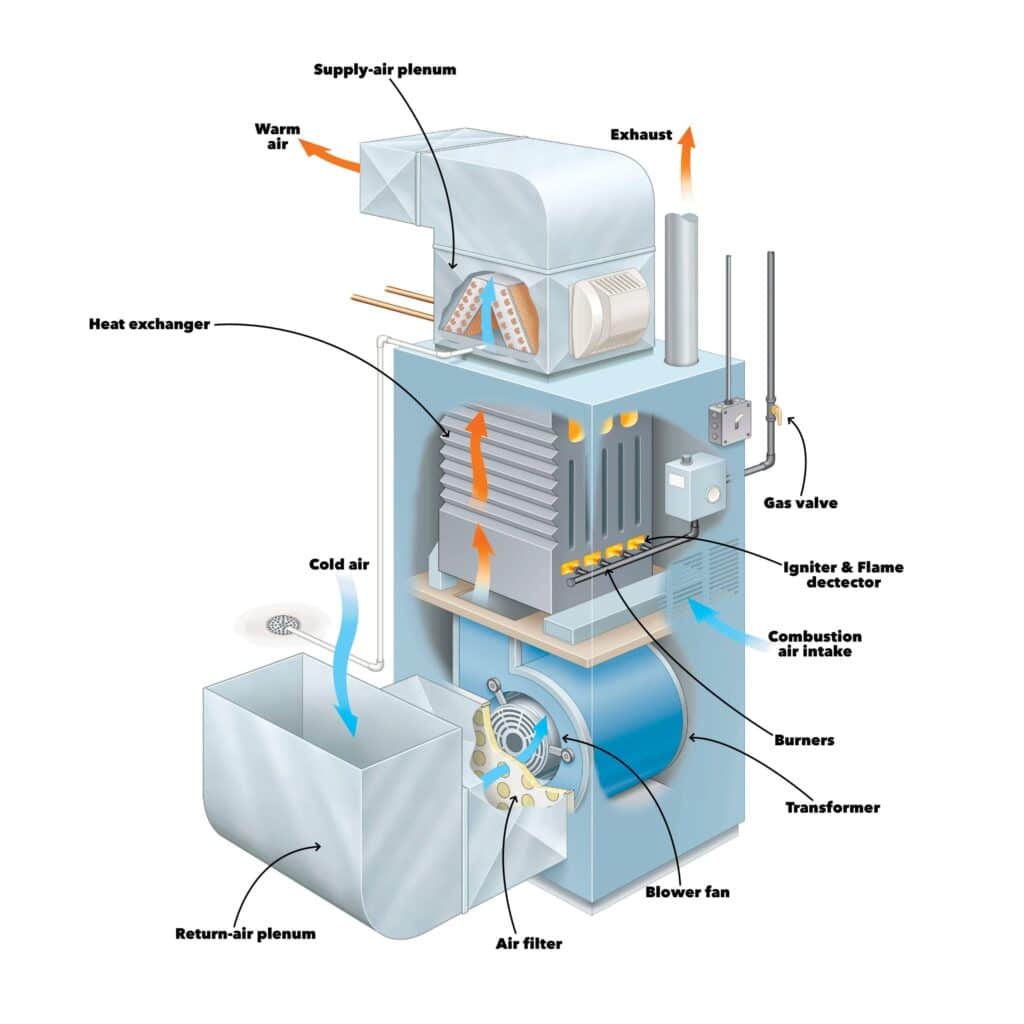Furnace Heat Exchanger: Function, Lifespan & Warning Signs

Table of Contents
Your furnace is vital to keeping your house warm and at the center of its operation is the heat exchanger. This part transfers heat from the burning process into the air that is moving through your house. Its absence would allow the harmful gases generated during combustion to combine with the warm air and pose serious health threats.
Every gas- and oil-burning furnace has a heat exchanger, but electric furnaces do not need one because they do not burn fuel. We can choose steel, cast iron, aluminum, and more in order to shape its design. Their main job is to make sure the heat created by burning the fuel is fully captured while keeping the nasty gases in.
How a Furnace Heat Exchanger Works
The heat exchange process enables combustion exhaust gases to flow through one side of the device while home interior air travels through the opposite side. Exchanger tubes made of metal draw heat energy from exhaust gases for the processing of clean home air distribution.
Higher efficiency gas furnaces include one or two additional heat exchangers which extract maximum heat from the waste gases. The process generates enhanced energy performance through turning heated air into water thus minimizing heat loss. The safe removal process of leftover furnace gases happens through corrosion-resistant PVC exhaust pipes instead of traditional metal vent systems found in regular furnaces.
Signs of a Failing Heat Exchanger
Extreme temperature changes eventually cause all heat exchangers to breakdown. Carbon monoxide leaks become hazardous because heat exchangers suffer from fractures and corrosion and experience rusting.
A failed heat exchanger produces abnormally lasting odors that serve as an obvious sign of device malfunction. Two warning indications of heat exchanger failure include soot accumulation near burners and visible fractures in metal tubes. It is crucial to place a carbon monoxide detector near your furnace because it will warn you about dangerous leaks before they become hazardous.
Lifespan of a Furnace Heat Exchanger
Heat exchanger survival duration depends on two factors – the material choice and the model type of the furnace device. Steel heat exchangers normally exist for fifteen to twenty years yet cast-iron versions can continue operating for forty to fifty years. Manufacturers American Standard and Bryant extend lifelong warranties for their furnace components to their users. The furnace component warranties of Carrier, Heil, Rheem and Janitrol cover a period of 20 years for their standard and high-efficiency unit lines.
Replacing a Faulty Heat Exchanger: DIY or Professional Help?
Caretakers must seek professional help when it comes to heat exchanger replacement. Heat exchanger replacement demands specialized tools through a process which seeks to fully disassemble and reintegrate the furnace system. Sealing the heat exchanger properly remains essential to avoid carbon monoxide leakage so the job requires professional involvement. Local regulations establish that examinations and replacements need to be done solely by certified technicians.

Cost of Heat Exchanger Replacement
The financial cost for replacing a heat exchanger extends to $3,000. Homeowners need only a slight increase in budget to get an entirely new furnace system so they decide to replace their entire system instead of repairing the heat exchanger. Other damaged furnace components might indicate that a system upgrade would provide better value than fixing the exchanger alone.
Common Furnace Questions and Key Components Explained
New homeowners trying to gain a better understanding of their furnace will find the following information answers their most common queries.
What Is a Furnace? A furnace operates as a heat production device that outputs heated air for residential distribution.
How Does a Gas Furnace Work? Inside the heat exchanger hot temperatures produced from fuel burning pass through to heat the surrounding air.
The measurement systems used to evaluate furnace heat usage efficiency operate under the name “Furnace Energy Efficiency Ratings.” Furnace fuel-to-heat efficiency measurement appears in ratings formats.
What Does a Furnace Inducer Motor Do? Before ignition the furnace system uses its inducer motor to safely remove combustion gases.
How Much Does It Cost to Replace a Furnace Blower Motor? Furnace model determines price points for the blower motor replacement and prices typically range from $400 to $1,500.
People Often Debate Whether a Heat Pump or a Furnace Makes the Better Heating Choice The selection of heat source depends on where you live as well as energy pricing and comfort requirements.
Final Thoughts
Proper functioning heat exchangers provide both safety measures and operational efficiency for your furnace system. Scheduled check-ups combined with maintenance help identify problems in advance to stop both expensive repair work and threatening carbon monoxide leaks. Professional furnace services provided by Prime Genius Heating, Air & Appliances at (916) 800-4007 should be contacted whenever you believe your heat exchanger could have problems to ensure both safety and warmth in your home.






